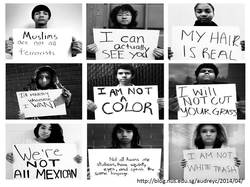
A recent evening spent with a group of university students confirmed my belief of how important it is to discuss social stereotypes with students, and help them understand the danger of relying on such stereotypes to define the world around them.
In the long run, this mentality can have a negative impact that will impede their ability to move forward in a multicultural environment whether academic or professional.
It has been my experience that, many students arrive at the university with these stereotypes in hand based on family background, culture, peer contacts and more. In many instances, I have found that their previous educational environment actively role modeled whether consciously or unconsciously this negative ideology.
After patiently discussing their frequent use of social stereotypes, I then witnessed their adamant insistence that such terms and comments were neither painful or wrong to say. It was only when I shared with them the equally biased comments that could be said about them were they willing to listen! In that brief moment, I encouraged them to take into consideration the people they first hear using such user of such social stereotypes, and the history that accompanied such behavior.
It was at that moment that I understood my mother’s comment that sometimes we should not leave people alone in their own head! We may need to jump in their head with them!
Being proactive, I came home and quickly started exploring ways to further examine these critical issues with the students because I knew that one quick dinner was not enough. This was certain to be an ongoing process. In addition, I also shared this article with them the next morning and so the dialogue began…
Cultural Stereotypes: Superficially Humorous But Potentially Harmful (written by: Gustavo Lequerica-Calvo • edited by: Rebecca Scudder • updated: 9/30/2014)
Cultural stereotypes may seem humorous but they can harm people. While many people understand and accept this as true, a "case study" approach, in the form of personal testimony, is often more valuable than a truckload of research.
This article is about my own personal experience with stereotypes. I rarely write in the first person, but this is a topic that merits a deviation from my journalistic practice of assuming a neutral voice. What I have to say is valuable to anyone interested in cross-cultural communication, because stereotypes are an extreme example of cross-cultural miscommunication.
Stereotypes are Distorted Taxonomies: Most likely, all of us grew up hearing comments from our parents or peers about certain individuals or the way they acted. At some point we began to wonder why our parents or friends had said something awful or funny about a person having to do with their being gay, Jewish, Black, Latino, Chinese or a member of some other identifiable social or ethnic category.On one level, people need to classify everything they encounter in order to know how to deal with them and define themselves as members of their own group. Thus, in certain social situations stereotypes serve to provide "answers" to questions about how we should act toward others. The problem is that stereotypes are distorted taxonomies: incorrect maps of the sociocultural landscape. Just as a distorted map would cause a traveler to become lost, so do false impressions about people and groups cause individuals and indeed, whole societies to lose their moral compass.
The Psyche of a Group: Growing up in Cartagena, Colombia, where the local population is overwhelmingly African Colombian, I heard the African Colombians telling jokes about other African Colombians, or the Cartageneros telling jokes about how lazy the Cartageneros are, or how the rest of the Caribbean Coast of Colombia is just one big patio for a party. Although it wasn't true, it was funny to hear at the time. One aspect of culture in the northern part of Colombia is to tell self-consciously mocking jokes about one's own type.One example of how a stereotype can erupt into violence can be found in the murder of a teacher named Rolando Perez. When he was murdered, everyone spoke of the act as a crime of passion instead of as the hate crime that it was. I offer the following translation of a portion of the local media's coverage of this crime. The police Coronel of Cartagena said “At any rate, this fellow lived a dissolute life. He was promiscuous. As a gay man, he had a lot of lovers.” The Coronel was unable to see the way in which a stereotype about gays could be clouding his own professional judgment in dealing with the case. The sexual orientation of the victim was elevated to such a level of importance that it explained away, even justified murder -- despite the fact that he was one of the most respected teachers in the city. He was known for his ability to inspire his students to reach their full intellectual potential.
Stereotypes in Mainstream Society- I am not advocating burying our heads in the sand in some form of smug political correctness. As I mentioned at the beginning of this article, stereotypes are part of the social dynamics and humor of every civilization of the world. We see them in popular entertainment on television: on Comedy Central, for instance. Stereotypes are the stuff that stock characters are made of, such as the “magical negro” an African-American man who helps a white man throughout a story. The Jewish mother stereotype is used widely in comedies such as The Nanny, Will & Grace, South Park and to a lesser extent (surprisingly) in Seinfeld. The question we need to ask ourselves, individually and collectively, as the media exploits stereotyping in the name of humor, is whether the negative consequences of stereotypes is disproportionately greater than the laughs they generate.Another example more familiar to people in the US is the crime of Matthew Sheppard, or that of Brandon Teena, in which both were victims of the stereotypes that surround the gay community. These two people were victims of fear and bigotry from others who did not want them in their communities. What is worse, religion was used to sustain the moral values of the communities in which these crimes took place. While religion is a powerful unifying and spiritual force, these are examples of how it can be used almost as a murder weapon, generating or justifying fear and hatred, or as an accessory after the fact to assuage guilty consciences in the communities where these crimes took place.
The Best Antidote is the Truth - The best antidote to stereotypes is the truth. Wounds to the body can heal but the harm that words can cause can last forever, damaging someone emotionally for life. That is why it is important to measure your words and learn from the experiences of others and avoid saying things that distance people and find ways to lift up their common humanity.
Finally, my parents were certainly unconscious of what they were doing. They might not have believed it if someone had pointed it out to them--after all, most people see themselves as good and right. With effort, we can change ourselves and in so doing, change society. It is important to see the diversity that surrounds us as a good thing, something wonderful about the world. Isn't that better than living in our own cultural bubbles?
http://www.brighthubeducation.com/middle-school-social-studies-lessons/1690-dangers-of-stereotyping/

 RSS Feed
RSS Feed
